TURNER’S 1977 TRIUMPH
After the chastening experience of the 1974 America’s Cup Match, Alan Bond was anything but disheartened. Southern Cross had been out-gunned by Courageous in nearly every department and what the Australians were learning was that to win in Newport required a perfect confluence of design, sails, innovation and crew-work. Bond felt that in Bob Miller, soon to change his name to Ben Lexcen, that he had a rare breed of innovative designer prepared to think outside of the box to beat the Americans on their home turf.
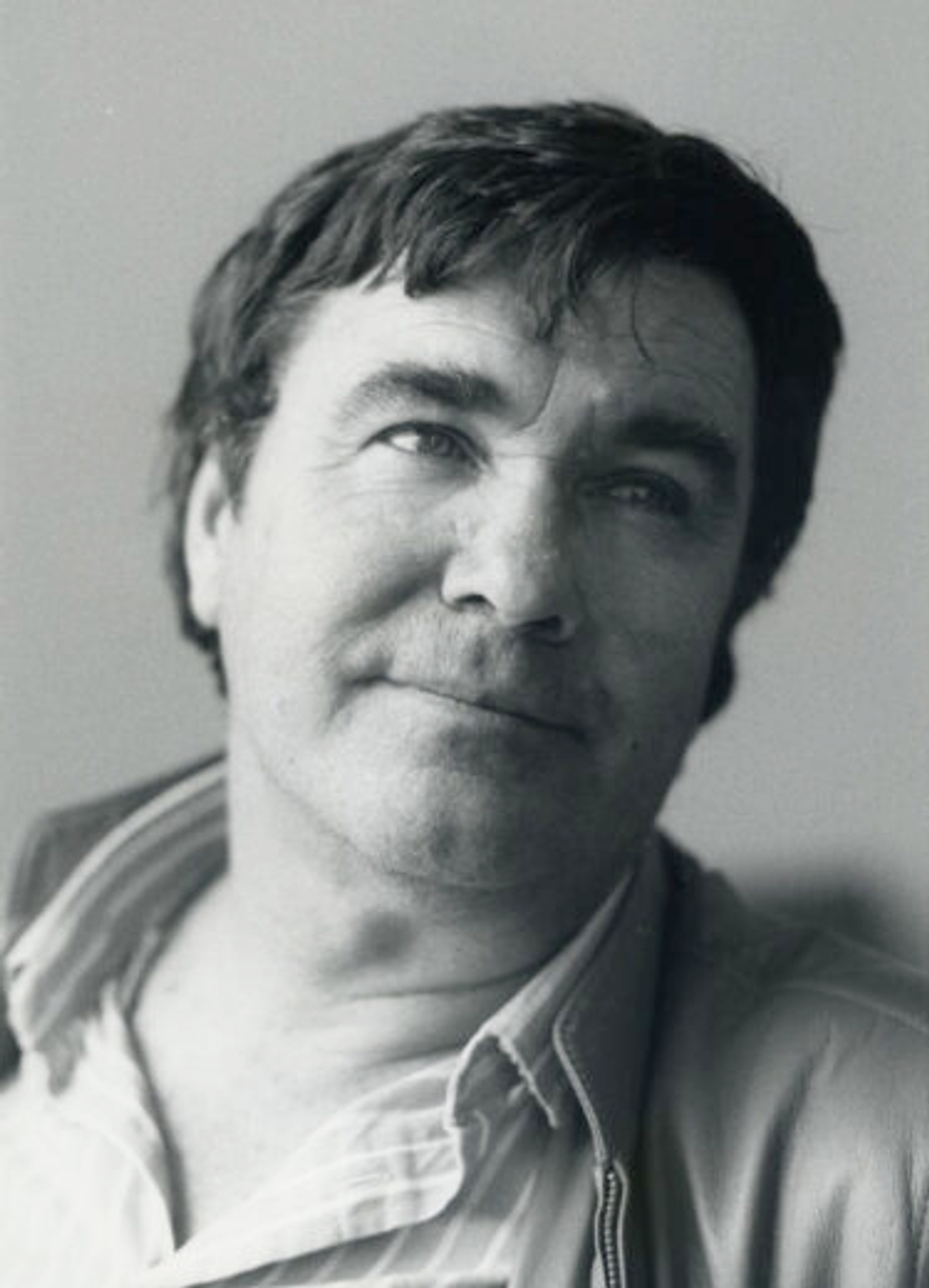
After the 1974 Cup, Lexcen had moved to Cowes on the Isle of Wight and was struggling to find design work. Bond pursued him first by telephone with the two falling-out and Lexcen slamming the phone down, before Bond travelled to Cowes and tracked him down, famously in a supermarket, and insisted that he came back to Perth. Lexcen agreed and furthermore, a burgeoning design relationship with Johan Valentijn had emerged during his time in England – one that proved crucial going forward.
Valentijn was a graduate of the Sparkman & Stephens design office and with deep knowledge of some of the fastest 12 Metres ever built, became crucial as a foil to Lexcen who had determined to build a lighter displacement boat than Southern Cross with increased sail area to better suit the Newport prevailing, late summer Cup conditions. The two designers opted to tank test at the University of Delft in Holland before presenting the lines of what would become ‘Australia’ to the Steve Ward boatyard in Perth with the challenge to come from the Sun City Yacht Club of Perth – Bond’s association with the Royal Sydney Yacht Squadron was somewhat scuppered by Jim Hardy attempting to form his own challenge under the auspices of the club.
The Australians were joined in the challenge for the 1977 America’s Cup by Baron Bich who had commissioned what proved to be a disastrous boat in ‘France II’ that was barely a match for the now aged ‘France I’ with an underwater profile, that appeared to drag tons of water astern. Early trials set skipper Bruno Troublé at odds with designer André Mauric but Troublé won every race steering the seven year-old ‘France I’ against trial skippers Pierre ‘Poppie’ Delfour steering ‘France II’ and Jean-Marie Le Guillot on the team’s other 12 Metre ‘Constellation’ in Newport. Troublé was thus appointed Cup skipper until misfortune struck when bearing away around a windward mark in training where a Barient winch exploded, hitting him hard in the chest, breaking five ribs and causing both liver and kidney damage. Delfour would take over French helming duties for 1977.
One of the more innovative challenges came, however, from the first ever entry to the America’s Cup of the Swedish with Pelle Petersen, a champion Starboat sailor, attracting sponsorship monies from Swedish industries and the Swedish King himself. Göran Rutgerson, was part of the crew and spoke fondly of the challenge some years later, saying: “The boat, which was special in many ways with its pedal-powered coffee grinders and tiller steering, was baptised to ‘Sverige’ by Queen Silvia.
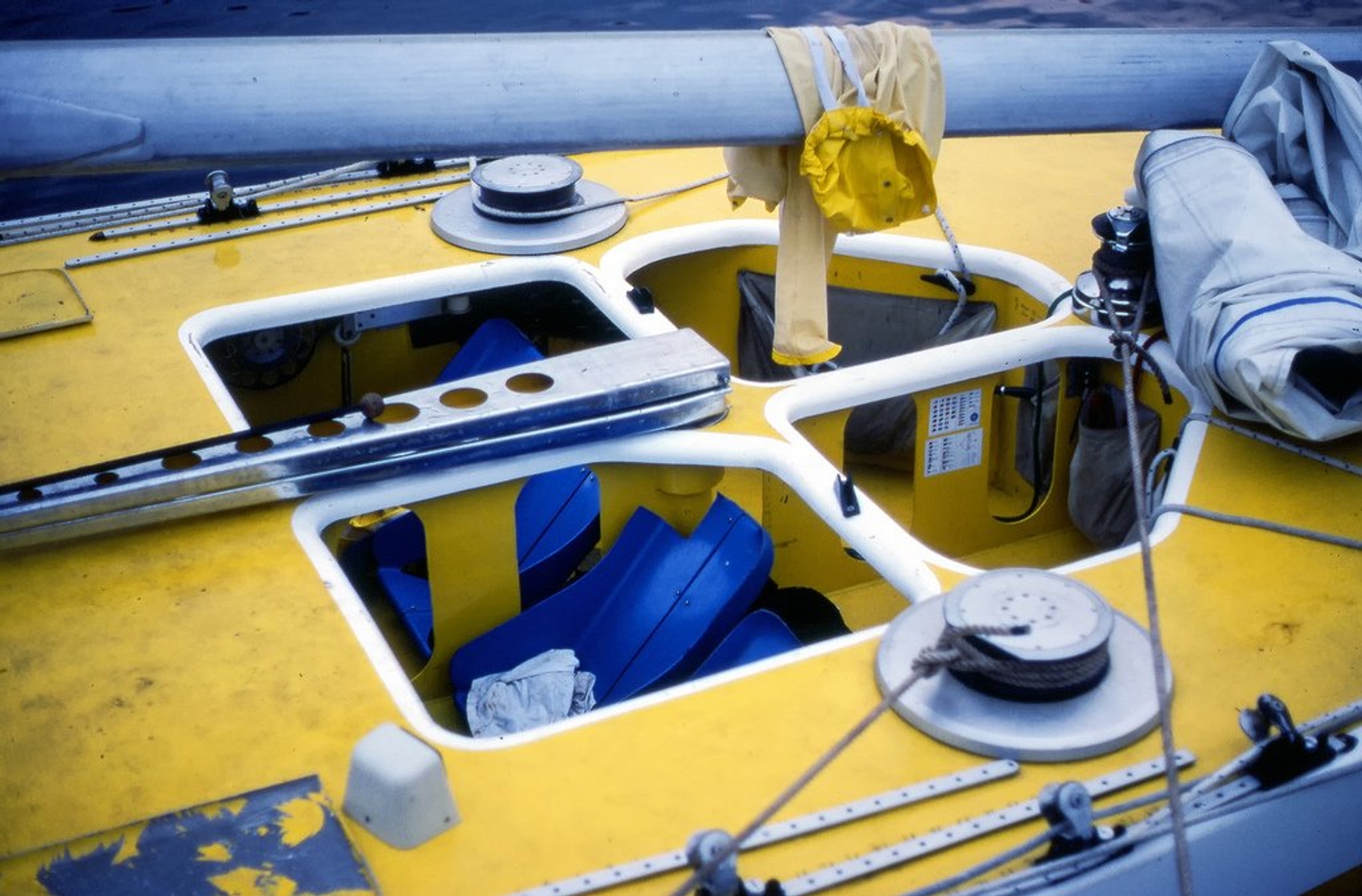
The name is the Swedish word for Sweden and is pronounced ‘Sve-ree-yeah.’ Other than myself and Pelle Petterson, who was the skipper, the crew consisted of today’s legendary sailors like Magnus Olsson, Gösta Holmin and Stellan Westerdahl. At the time, we were all young and eager, but did not have much experience compared to many of the other participants. Considering this we did well in the challenger trials, beating ‘Gretel II’ and ‘France’ but eventually lost in the finals against ‘Australia.’

Gordon Ingate, the Australian Olympic representative in the Tempest Class at the 1972 Games, put together an innovative and well thought out challenge for 1977 after extensive consultation with designer Alan Payne. The two initially disagreed on direction but Ingate had determined that in trials in 1974 between Gretel II, the old warhorse that contested the Match in 1970 against Intrepid, and Southern Cross, that in certain conditions, Gretel II was faster than the ultimate winner of the 1974 Cup, Courageous. Payne and Ingate set out to re-build Gretel II with a new deck that narrowed the beam by sloping the topsides inwards from the waterline and angled the boat to be fast in breezes up to 12 knots as could be expected in the August challenger series in Newport. Above that speed, Gretel II would be at a serious disadvantage. Ingate assembled an experienced crew with an average age of 40, mainly from his all-conquering 1967 Admiral’s Cup team and the team arrived in Newport with T-shirts emblazoned with the line: “Daughters of America, lock up your mothers!”
Whilst the Challengers assembled, the New York Yacht Club got to work on the defence with two syndicates and three boats contesting the slot. The Sparkman & Stephens design office were commissioned by Lowell North to create Enterprise which was funded by Fritz and Lucy Jewett with tax breaks being afforded by the syndicate’s association with the Fort Shuyler Foundation. The North loft, so often the key and the stand-out innovator in sail design had, under the direction of Lowell North and John Marshall introduced computerised design that allowed performance statistics to be tested against dimensions and with this new scientific approach, the Sparkman & Stephens office were obliged to follow suit.
Enterprise was built at Minneford’s Yard on City island but trucked across to San Diego for early trials against Intrepid and North took the decision to install Malin Burnham as upwind helm whilst North, Marshall and Rich Du Moulin would offer tactical input. Burnham was the youngest ever Star World Champion, winning in 1944 as crew to Gerald Driscoll at just 17 years old before winning as a helmsman, with Lowell North crewing, the following year in 1945.
Ted Hood meanwhile went a very different way in the overall design approach, eschewing tank-testing and backing his own eye and feel for the lines of what would become ‘Independence’ allied for tax purposes with the Merchant Marine Academy. Also, within the Independence syndicate was Courageous, the 1974 Cup winner that was still eyed as an ultimate 12 Metre design of the era, that was bought predominantly as a benchmark for the newer vessel. Ted Turner, having seen the might of Courageous in the Defender trials in 1974, contacted Hood and offered his services so long as he could campaign Courageous with a chance of securing the defence slot. Hood agreed. The New York Yacht Club weren’t so sure, but Turner had a keen and competitive eye on collating the best sails from both the Hood and North lofts, knowing that neither would sail with cloth of the other.
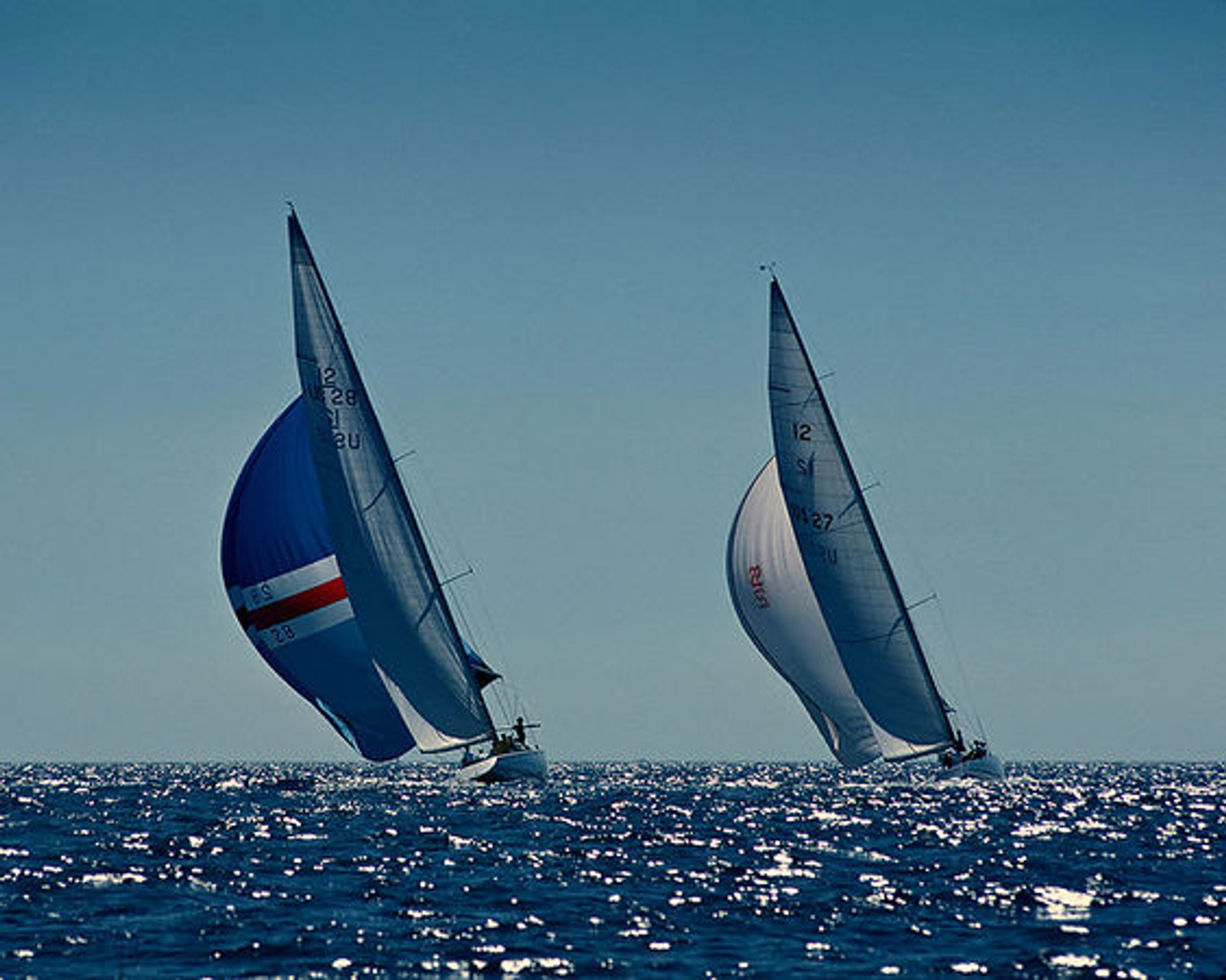
However, when the Defence trials started and after a stellar showing from Courageous who led, Turner was rebuffed in his attempts to buy North Sails with the Enterprise syndicate hiding behind an agreement they had struck in May 1977 with the New York Yacht Club that only sail designs from 1974 could be purchased by any other syndicate. Turner was apoplectic – it was the start of a summer long feud between Lowell North and Turner - but stuck at the task before him, churning out close-fought wins through the observation trials that started in July. With Enterprise tinkering with new cloth patterns, cord depths and highly innovative Kevlar and mylar mix materials, and Independence seemingly always coming off tactically second best, Turner was on a roll and as he described: “The boat speed of all three boats is so close it's frightening, but there is one area that we are strongest – tactics.” And it was Turner’s intense and flourishing relationship with tactician Gary Jobson that proved key that summer.
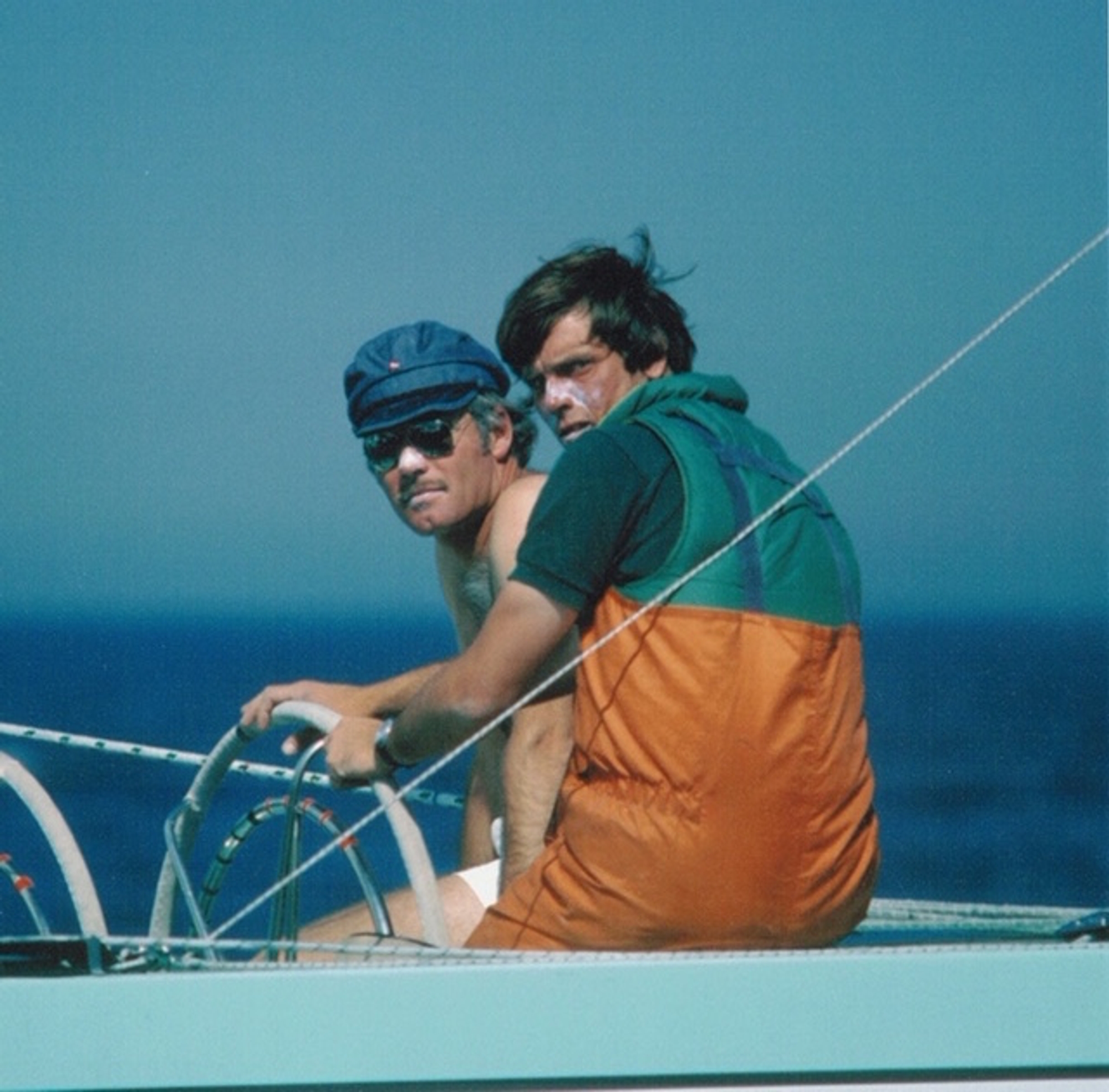
The Defence and Challenger selection trials ran almost concurrently for the Newport summer of 1977 and whilst the American syndicates worked up both their technology and crew-work, the Challengers were at various stages of preparedness. Baron Bich all but abandoned ‘France II’ just three weeks before the elimination races, concentrating all efforts into the 1970 ‘France I’ and a complete refit was ordered in a desperate attempt to keep his America’s Cup dream alive with boat builders being flow in from France as well as local Newport yards retained. It was classic Bich.
The Swedes were full of innovation with below-deck grinders and bendy mast sections whilst Gretel II was a potent threat in the lighter airs. Once the round robin racing was underway however, Australia was the stand-out performer, topping the ranks with a 5-2 win/loss scoreline and with first facing third it was a battle against ‘France I’ for a place in the Challenger Finals. Sverige and Gretel II fought it out for the other slot. Australia advanced with ease, winning 4-0 whilst the contest between Sverige and Gretel II went to a decider with Petersen just getting the edge on Ingate to set up an Australia/Sverige Challenger Final.
Noel Robins, the partially quadriplegic helmsman and skipper of Australia, sailed possibly the finest series of his life in the defeat of Sverige, overturning a huge deficit in the first race for a back-from-the-dead victory having been some 4 minutes behind at the second mark. Then, as the winds increased in the series, the Australians strode to a 3-0 lead before in the final race, Robins put Petersen over the start line early and after a bizarre race where the Swedes ended up on the wrong side of an enormous shift, the finishing delta was over 13 minutes. Australia advanced to the Match but Petersen agreed to keep racing and tuning with them, holding a further two races – both won by Australia.
The Defence trials were somewhat closer. However, the lingering doubts about Ted Turner within the hierarchy of the New York Yacht Club persisted. Many years later, Gary Jobson opined that: “I think the New York Yacht Club realised that Turner had the talent and the crew was good, and Courageous might be the right boat, but what about this mercurial southerner? Should he really be representing the New York Yacht Club in the America’s Cup? I think those of us in the boat bet they were looking for any excuse to get us eliminated and the only way to keep going was to keep winning.”
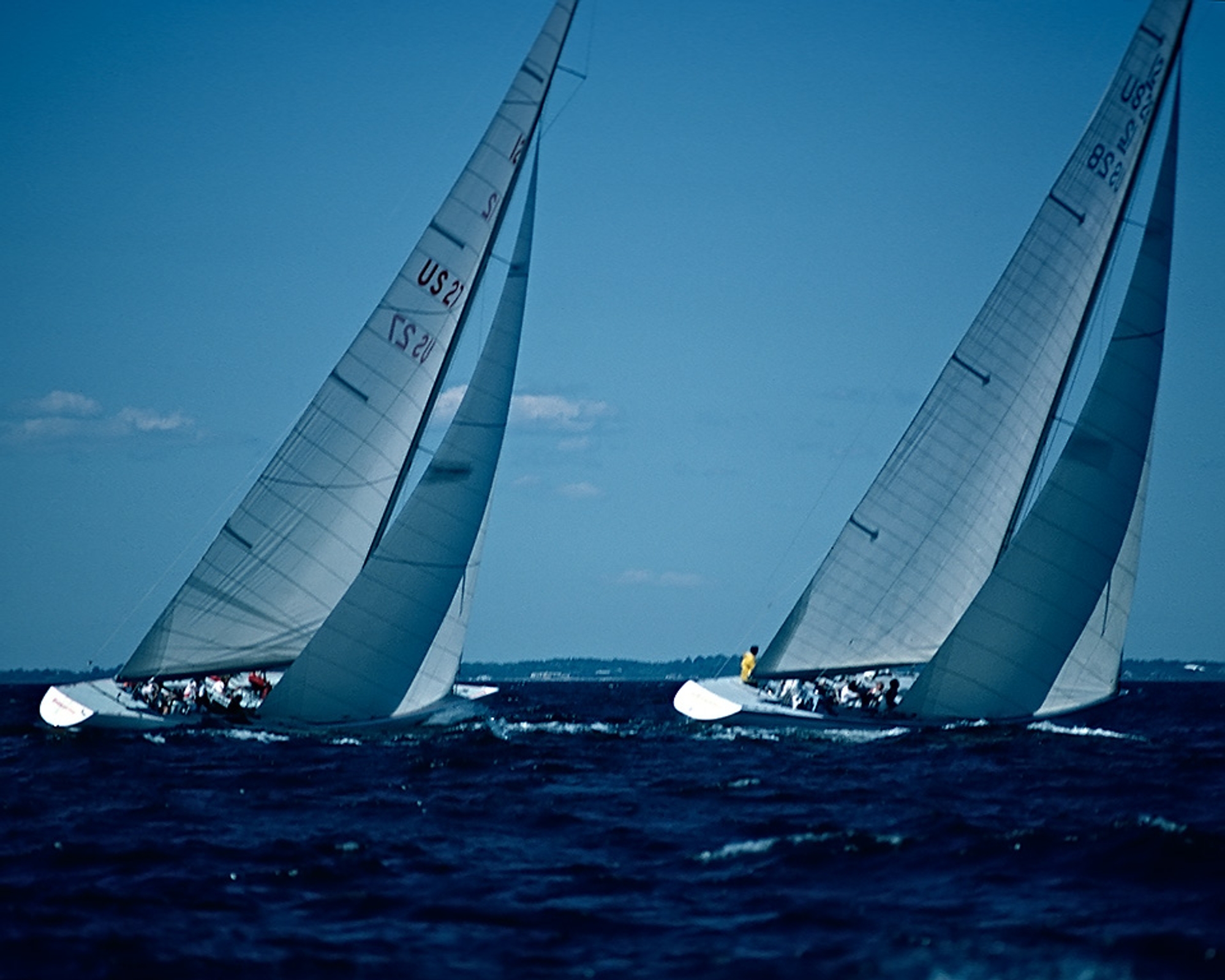
And win they did, starting the defence trials with five straight wins before finally losing a race to Independence. For Enterprise it was a difficult start, losing two straight races to Courageous and then sharing a two-race day with Independence. Lowell North was tinkering still with Enterprise and after another shared day with Independence before fog ruled out sailing for two days, shoreside North was fired with Halsey Herreshoff coming onboard to boost the afterguard and Malin Burnham instated as skipper. It had little effect initially and Ted Turner was quick to capitalise on the disarray in the Enterprise camp, thumping in two victories as racing resumed and a further victory against Independence the following day.
Ted Hood’s hopes were fading fast too even after replacing tactician Scott Perry with Steve Van Dyck and two further defeats by Enterprise and a 1 minute 23 second victory by Courageous saw the straw boater wearing Committee of the NYYC thanking Hood for his participation and excusing Independence from further trials. Ted Turner sealed the Defence nomination for Courageous the following day on Tuesday 30th August 1977 with a resounding, tactically brilliant race against Enterprise that saw Courageous on the right side of two shifts on the first leg and, never headed, sailed off to a 1 minute 26 second victory.
There was no other choice, Courageous with Ted Turner, the ‘Mouth from the South’ was the nominated Defender for the America’s Cup having lost just one race from 11 in the trials. Devastating performance and right when it mattered.
After being informed of his nomination to defend the America’s Cup by the NYYC Committee, Turner had commented: “There will never be a time in my life as good as this time. I can’t believe all this is really happening to me.” So, with confidence high, the crew of Courageous, led by a skipper very much at his prime – Turner was 38 years old – the Americans faced a familiar foe, one they had encountered many times on the global grand prix yachting circuit, in Alan Bond.
Bond’s campaign had been one of steady improvement, something that had been monitored from afar by the Courageous syndicate who knew they were facing a much faster threat than Southern Cross posed in 1974. The Australians had controversially brought in match-racing ace and American national Andy Rose to the afterguard as tactician just before the semi-finals of the Challenger Series, and the move seemed to work with Rose gelling with Robins well. All was set for the 1977 Match.
It was September 13th, 1977, and Newport was cold with a 12 knot breeze blowing from the south by the time the boats arrived at the racecourse after the customary long tow out from their Newport Rhode Island bases. The pre-start circling was naturally aggressive as had become the norm in modern match-racing and with just 30 seconds left on the clock, both boats hardened up on timed-runs to the line on starboard tack. Gary Jobson, tactician on Courageous, called for Turner to hold the right and in the dying seconds, Turner tacked off on to port leaving Australia to head for the pin end of the line.
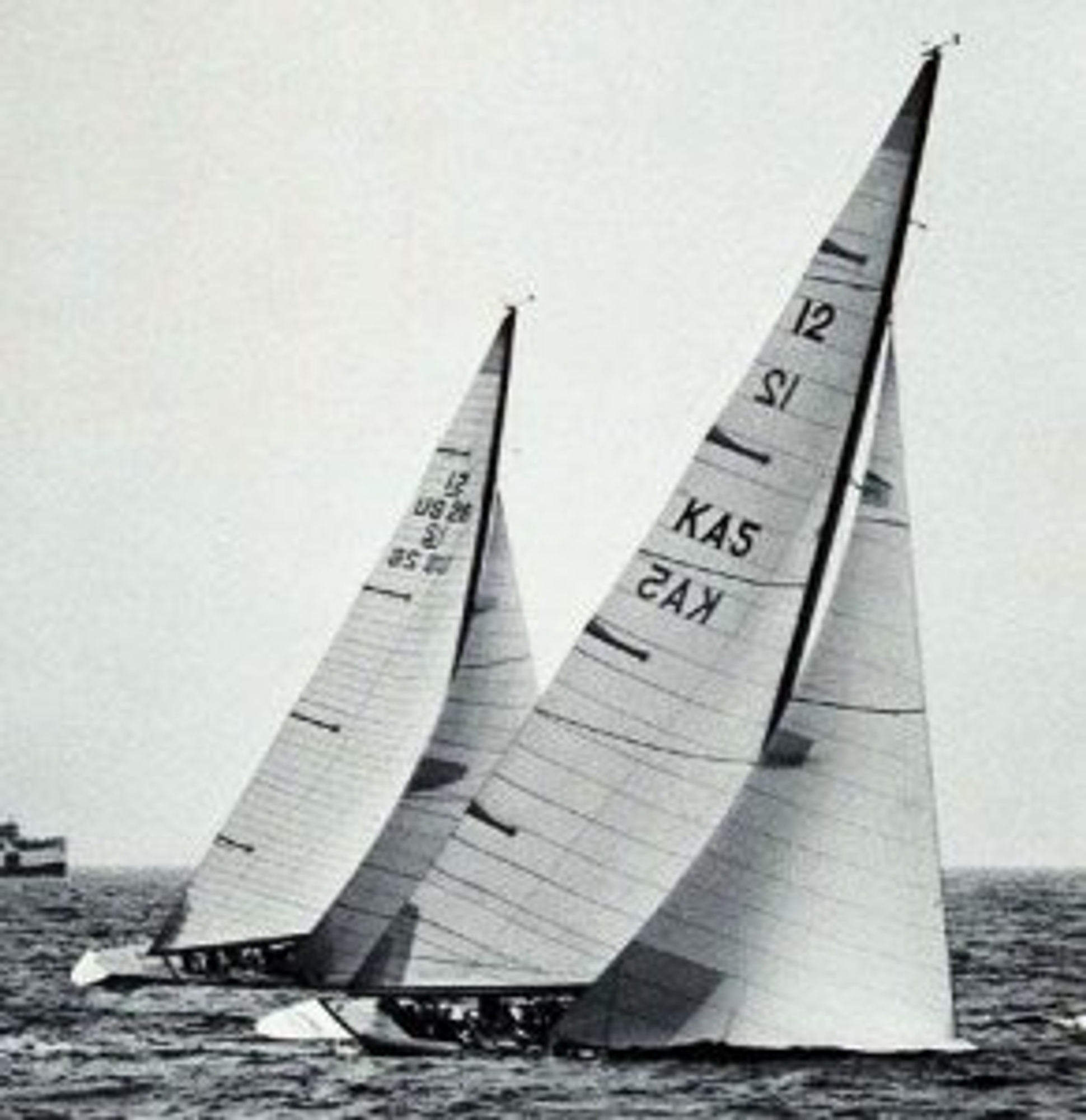
Both boats were late for the start line but with an expected veer out on the starboard layline, Australia came back on to port to follow Courageous after five minutes of windward work. With Courageous able to point consistently higher, the gauge visually decreased over a port tack leg that lasted for some 17 minutes. When Courageous tacked, she was easily crossing Australia so Rose called for a tack beneath in what should have been a relatively clear leeward position, however the call was too late and Turner just eased Courageous over the top, blanketing the Australian’s sails. Robins tacked immediately, a move that Turner ignored, electing to sail out of phase to the windward mark. It was brilliant tactical sailing in the conditions and Courageous rounded mark one with a lead of 1 minute and 8 seconds and headed off on a reach to the wing mark, setting her spinnaker with perfect crew co-ordination.
The expected offwind performance of Australia failed to materialise on the two reaching legs and Courageous was ahead by 1 minute 23 seconds at the first leeward mark but closed up on the next beat courtesy of a favourable 20 degree windshift. Encouragingly though for Courageous whose tactician Gary Jobson had casually recorded the speed of Australia whilst training some weeks earlier and had chosen to keep the data to himself, the final run saw Courageous extend marginally before turning for home and stretching away. The final delta was 1 minute 48 seconds with the Australians ruing their choice of headsail and a lay day was called to re-group.
When the boats came back out for race two on the 15th September 1977, a rather familiar pattern began to emerge – that of Courageous being able to pinch higher to the wind than the Australians – and despite the race being abandoned as the 4.40pm time limit was breached, the Australians knew they had a problem with the American’s speed and point. When race two was re-run in just 11 knots of southerly unstable air, it was the sort of conditions that Ben Lexcen and Johan Valentijn had in mind when they designed Australia.
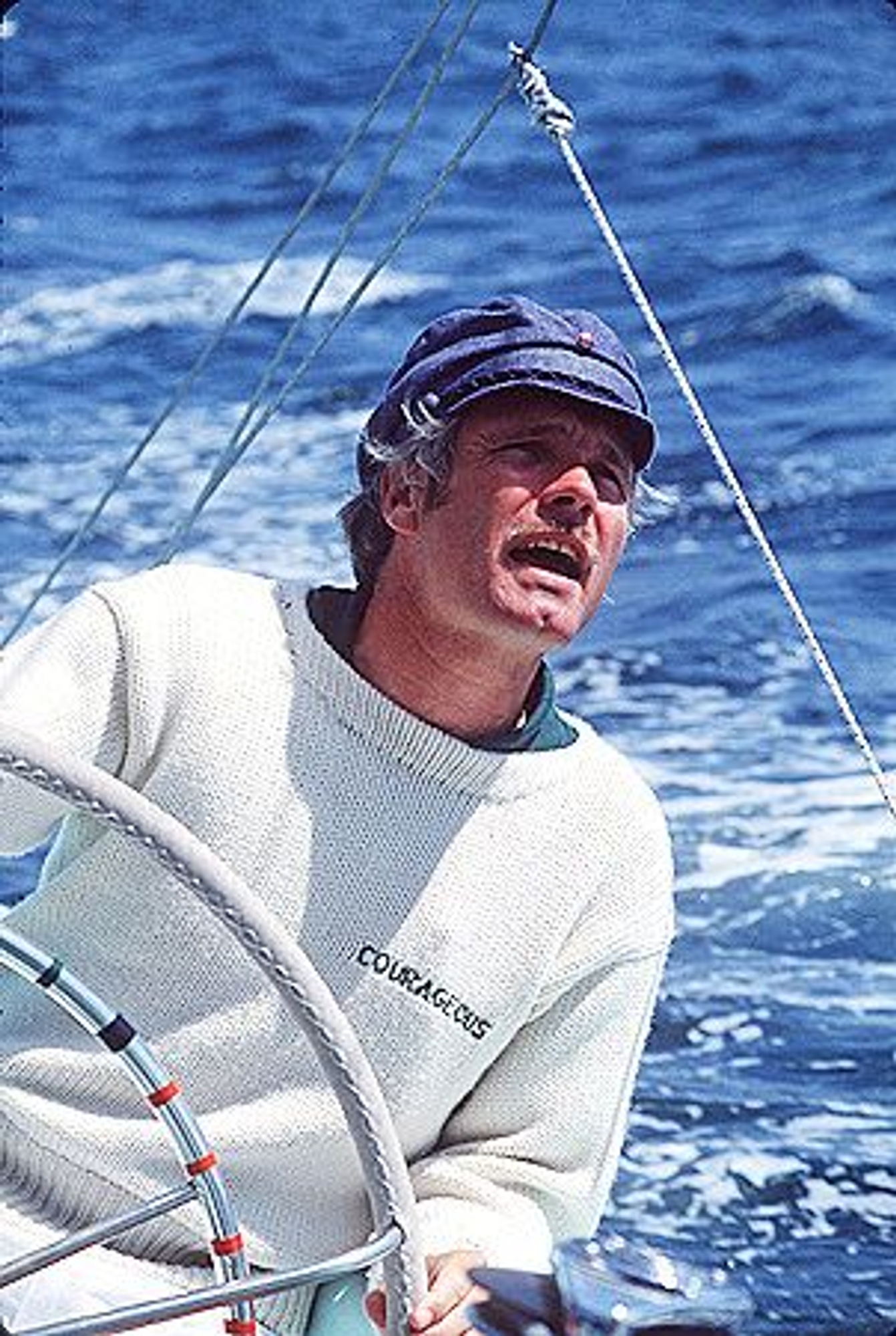
However, Turner made the best of the pre-start, trailing Australia down to the committee boat before gybing first and setting up in the leeward position, confident of his boat’s ability to hold and gain in a lane. Australia though held solid to windward for the opening minutes and when Courageous tacked to come back on port, Turner, unable to cross opted for an aggressive lee bow tack setting right up underneath the Australians and it was effectively the move that won the race. Australia was forced to tack off and in doing so, opted to change headsails that cost them time that they could simply never make up. Courageous led by two minutes at the top mark.
Australia though were in this race to fight and despite rounding the leeward mark after the first two reaches, some 2 minutes 48 seconds adrift, managed to take 30 seconds out of Courageous on the second beat. With the wind building up to 15 knots for the run, Australia closed by another minute, setting the two up for a final beat where Courageous tenaciously covered to win by a delta of 1 minute and 3 seconds. It was 2-0 to Turner and the defence of the America’s Cup was on.
Race three dawned as a typical Newport late summer day with fog reluctant to lift and a persistent mizzle blowing around on an 8-knot unstable south westerly. The pre-start was an anodyne affair with the two boats shadow-boxing in the circling and never really engaging. In the final moments, Courageous had set-up to leeward and ahead on starboard tack for the lead into the line and with no other option Noel Robins wheeled away onto port, crossing some six seconds down and heading right. Turner and Jobson realised that they had to keep close in the veering wind so tacked over to cover after 45 seconds and a long drag race ensued out to the west. Spectators observed that at various times, both boats locked into favourable shifts that put either one ahead, and arguably if Australia had tacked on one noticeable header she would have at the very least engaged with Courageous. Robins and Rose didn’t take the opportunity, claiming afterwards that they would not have been able to cross (but they didn’t have to?) and when the wind came back in favour of Courageous, the race was as good as lost.
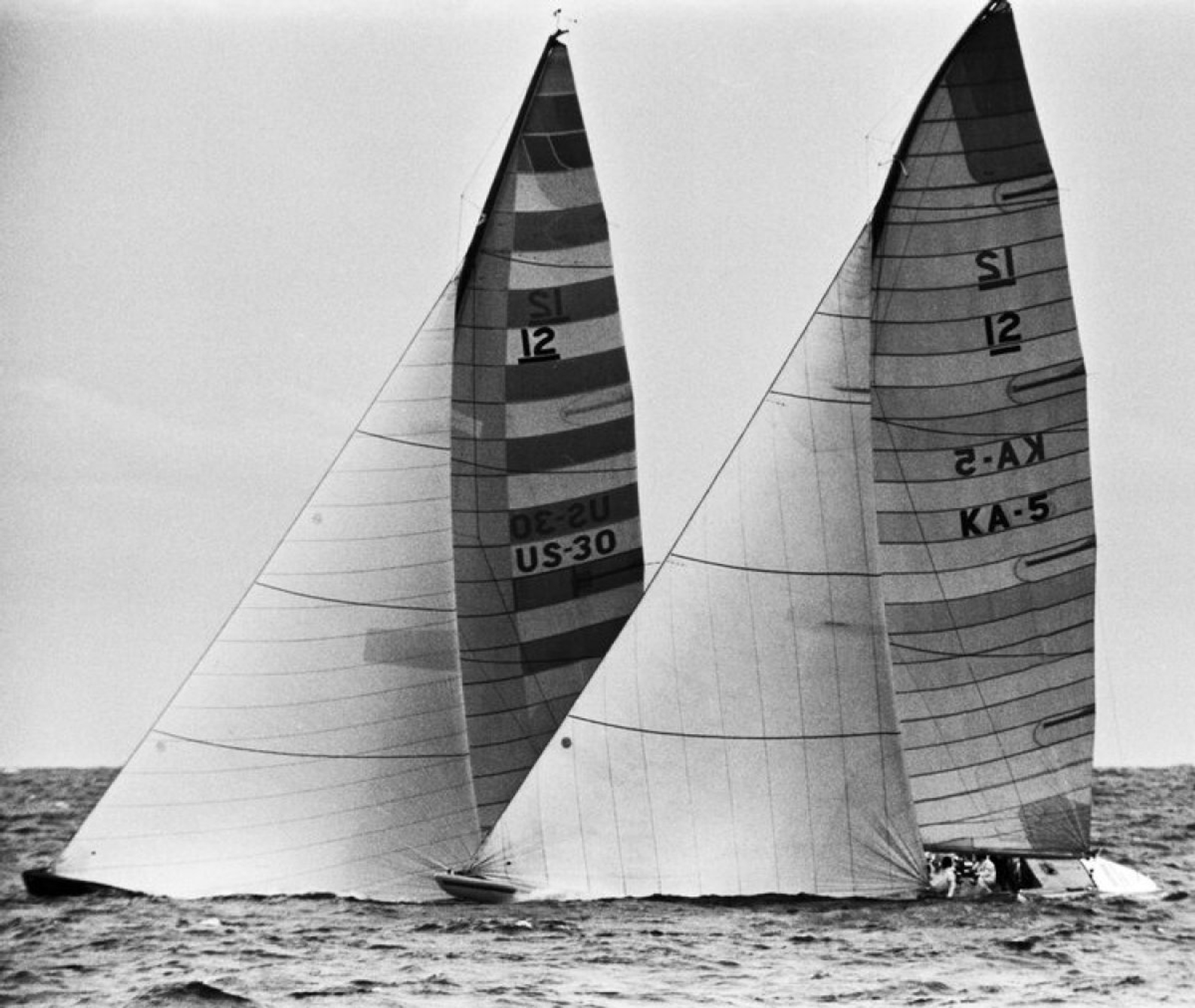
Turner and Jobson were in marvellous sync, rounding the top mark 1 minute and 50 seconds ahead and despite the breeze veering on the first reach causing both boats to gybe, by the first leeward mark they had extended to just over three minutes ahead. That lead was extended further on the second beat to some 3 minutes 27 seconds before the Australians clawed their way back into the race on the final run as they brought down extra pressure and rounded 1 minutes 57 seconds astern at the final leeward mark. Courageous kept a close cover on the final beat to cross the finish line and record a 2 minute 32 second victory as the “Rocky’ theme tune blared from a Coast Guard cutter. The writing was on the wall for Alan Bond’s Australia campaign but, ever the optimist, in the press conference afterwards declared that more breeze would favour the Australians and that a better performance was on the cards. It was false hope.
The final race begun in some 14 knots – the wind Gods had answered Bond’s prayers – but the differences between the two boats were perhaps amplified by the conditions. Both boats started on port tack with Courageous to leeward and pointing so well that Australia just couldn’t roll over the top and was forced to eventually tack away. Turner followed in quick pursuit and, now on starboard, held the advantage. Robins tacked and ducked the stern of Courageous and the call onboard the American boat was to stand on with the afterguard believing they were in a lift, and it was a full two minutes before they tacked to cover. When they did, the cross was easy, and the lift thus confirmed. At the top mark Courageous was 44 seconds ahead and headed off on the two reaches with confidence in their downwind speed to stay ahead. By the leeward mark the Americans had stretched the lead to 56 seconds and as the wind began to drop, the second windward leg saw a tactical masterclass of Newport sailing as Courageous streaked into a 2 minute and 11 second lead that they further extended on the run. By the finish line, it was a slam-dunk and the winning margin was 2 minutes 25 seconds as Newport went wild for their new hero in Ted Turner.
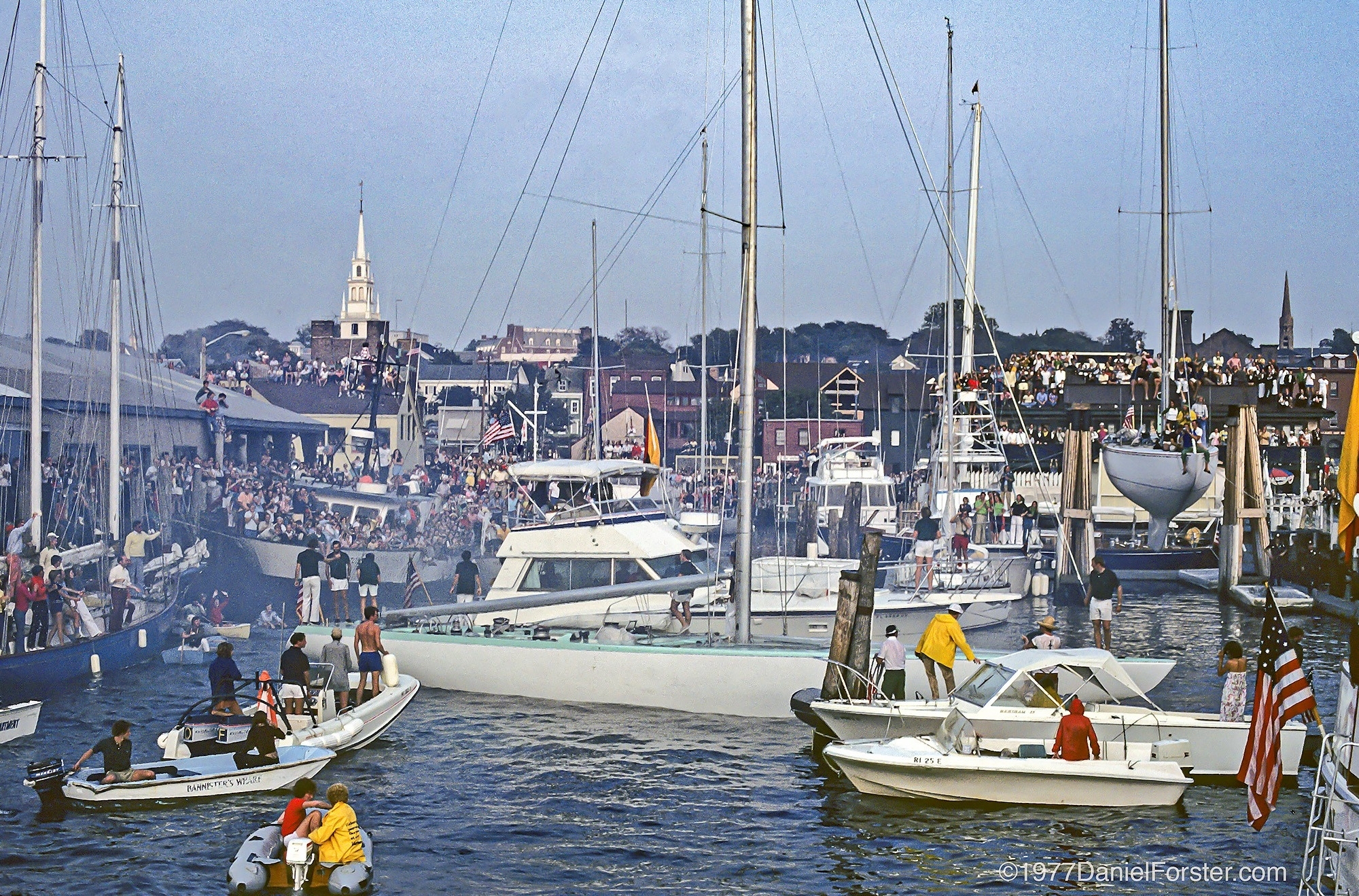
Much has been written about the immediate aftermath of the 1977 contest and in particular an unfortunate, rather intoxicated, press conference that occurred immediately after the racing. However, some 32 years later, Gary Jobson, tactician for Courageous caught up with his old crew and asked for recollections of the 1977 Cup to place in an American journal (Sailing World) and Ted Turner offered a snapshot that summed up that summer beautifully: “I think the ’77 Cup race was a high point of our lives. We were the underdogs going into that summer. We were going to have to perform at an absolutely superlative level. It was a crew of 100-percent winners.”
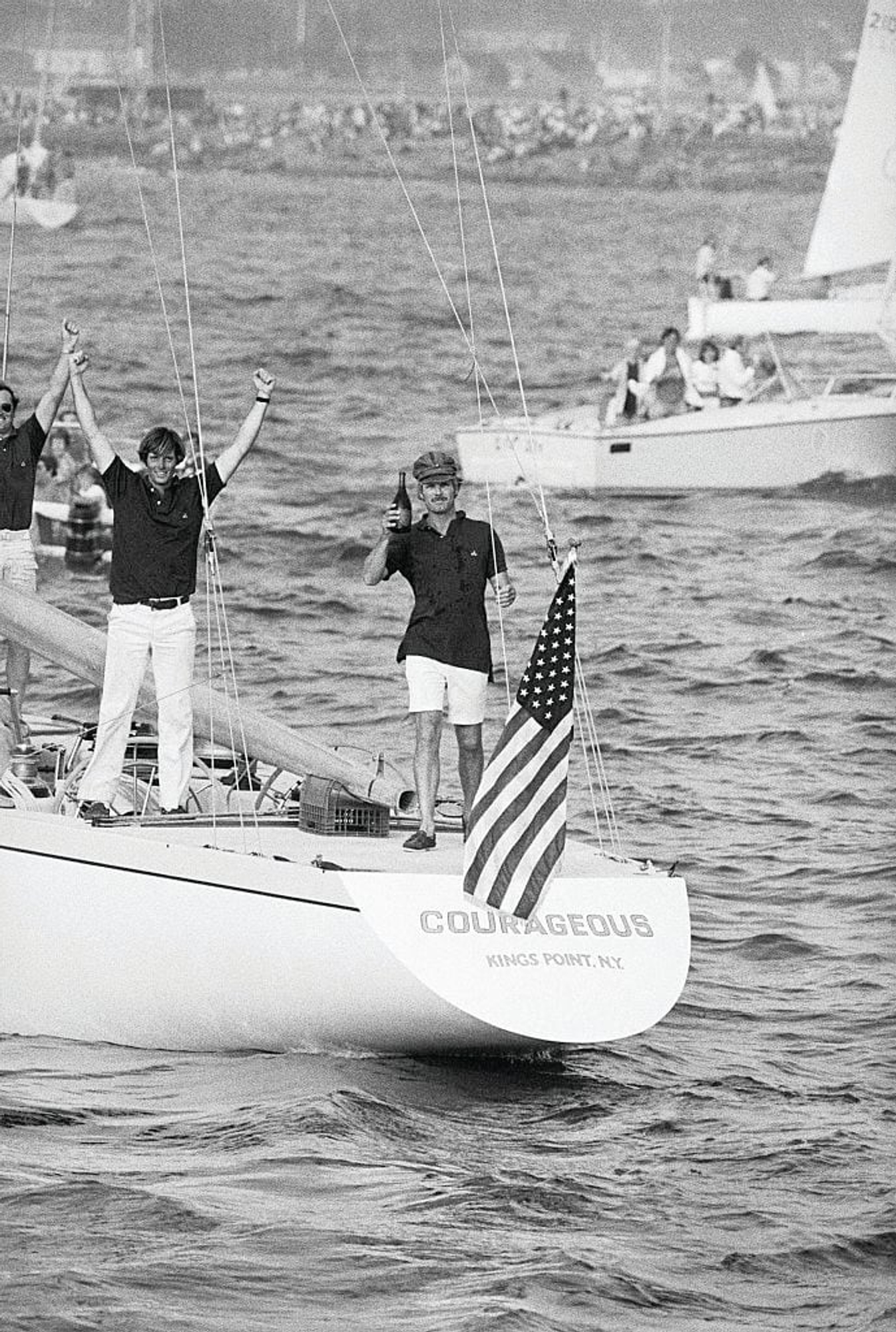
The America’s Cup had been defended in style by one of the true mavericks and characters of the event’s long history and the Auld Mug was safe once again in West 44th Street, home of the New York Yacht Club. Ted Turner meanwhile had: “rocketed from famous to superstar,” according to the New York Times. The rest as they say, is history.